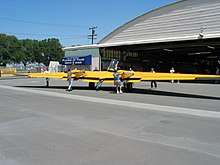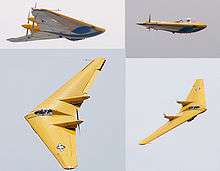Northrop N-9M
The Northrop N-9M was an approximately one-third scale, 60-ft span all-wing aircraft used for the development of the full size, 172-ft wingspan Northrop XB-35 and YB-35 flying wing long-range, heavy bomber. First flown in 1942, the N-9M (M for Model) was the third in a lineage of all-wing Northrop aircraft designs that began in 1929 when Jack Northrop succeeded in early experiments with his single pusher propeller, twin-tailed, twin-boom, all stressed metal skin Northrop X-216H monoplane,[1] and a decade later, the dual-propeller N-1M of 1939–1941.[2] Northrop's pioneering all-wing aircraft would lead Northrop Grumman many years later to eventually develop the advanced B-2 Spirit stealth bomber, which debuted in 1989 in US Air Force inventory.[3]
| N-9M | |
|---|---|
.jpg) | |
| The restored N-9MB in 2014 | |
| Role | Prototype |
| Manufacturer | Northrop Corporation |
| Designer | Jack Northrop |
| First flight | 27 December 1942 |
| Primary user | United States Air Force |
| Number built | 4 |
| Developed from | Northrop YB-35 |
Design and development
On 30 October 1941, the preliminary order for development of the B-35 Flying Wing bomber was confirmed, including engineering, testing, and most importantly a 60 ft (18 m) wingspan, one-third scale aircraft, designated N-9M.[4] It was to be used in gathering data on flight performance and for familiarizing pilots with the program's radical, all-wing design. The first N-9M was ordered in the original contract, but this was later expanded to three test aircraft in early 1943. A fourth was ordered a few months later after a crash of the first N-9M destroyed that airframe; this fourth N-9M incorporated various flight test-derived improvements and upgrades, including different, more powerful engines. The four aircraft were designated N-9M-1, -2, -A, and -B, respectively.[5]
The N-9M framework was partially constructed of wood to reduce its overall weight. The wings' outer surfaces were also skinned with a strong, specially laminated plywood. The central section (roughly equivalent to the fuselage) was made of welded tubular steel. The aircraft were originally powered by two 290 hp (216 kW) Menasco C6S-1 "Buccaneer" inverted air-cooled straight-six engines, driving twin-bladed propellers, except for the N-9MB which was powered by two 300 hp (224 kW) Franklin XO-540-7 engines.[4]
Operational history

The first flight of the N-9M occurred on 27 December 1942 with Northrop test pilot John Myers at the controls.[6] During the next five months, 45 flights were made. Nearly all were terminated by various mechanical failures, the Menasco engines being the primary source of the problems. After roughly 22.5 hours of accumulated flight time, the first N-9M crashed approximately 12 miles (19 km) west of Muroc Army Air Base (now Edwards Air Force Base) on 19 May 1943. The pilot, Max Constant, was killed as he attempted to recover the aircraft from a right-hand, 60° nose-down spin. The investigation found that Constant had suffered control reversal, the control column had been pressed against his chest during his recovery attempt from the steep spin, preventing him from parachuting to safety. Actions were taken to fix this problem and prevent it from happening on other N-9M test aircraft.[6]
When Northrop's Flying Wing bomber program was canceled, all remaining N-9M flight test aircraft, except for the final N-9MB, were scrapped. For more than three decades, it slowly deteriorated until the Chino, California Planes of Fame Air Museum acquired the aircraft in 1982 and began the labor-intensive restoration process. For the next two decades, former Northrop employees and other volunteers restored the N-9MB to its final flight configuration.[7] Since 1993, the yellow-and-blue Flying Wing has been exhibited, with flight demonstrations at several airshows every year.[8]
In April 2006, the N-9MB suffered an in-flight engine fire. The aircraft was landed safely with limited damage. Donations to the museum were solicited for its repair, and the aircraft was fully repaired to flight status. It was flown again during the annual Chino airshow on 15–16 May 2010.[7]
On 22 April 2019, N-9MB was destroyed shortly after takeoff, when it crashed into a prison yard in Norco, California.[9]
Specifications (N-9M)

General characteristics
- Crew: 1
- Capacity: 1 observer (N9MB)
- Length: 17 ft 9 in (5.4 m)
- Wingspan: 60 ft 0 in (18.3 m)
- Height: 6 ft 7 in (2 m)
- Wing area: 490 sq ft (45.5 m2)
- Airfoil: NACA 65-019
- Empty weight: 5,893 lb (2,673 kg)
- Gross weight: 13,946 lb (6,326 kg)
- Powerplant: 2 × Menasco C6S-4 "Buccaneer" 6-cyl. supercharged inverted air-cooled in-line piston engine, 275 hp (205 kW) each (N-9MB) 2x Franklin XO-540-7, 300 hp (224 kW) each
Performance
- Maximum speed: 258 mph (415 km/h, 224 kn)
- Range: 500 mi (800 km, 430 nmi)
- Service ceiling: 21,500 ft (6,600 m)
See also
Related development
Aircraft of comparable role, configuration and era
References
Notes
- "Flying Wing Is Successful In first Tests." Oor Mechanics, May 1930.
- O'Leary 2007, p. 62.
- Parker 2013, p. 93.
- O'Leary 2007, p. 65.
- Parker 2013, pp. 93, 102–106.
- O'Leary 2007, p. 66.
- O'Leary 2007, p. 68.
- Air & Space (Smithsonian), October/November 2003, Volume 18, Number 4, p. 12.
- "Plane Crashes in Prison Yard of Facility in Norco: FAA". KTLA. Retrieved 22 April 2019.
Bibliography
- Coleman, Ted. Jack Northrop and the Flying Wing: The Real Story Behind the Stealth Bomber. New York: Paragon House, 1988. ISBN 1-55778-079-X.
- Donald, David, editor. "Northrop Flying Wings", Encyclopedia of World Aircraft. Etobicoke, Ontario: Prospero Books, 1997. ISBN 1-85605-375-X.
- Maloney, Edward T. Northrop Flying Wings. Corona del Mar, California: World War II Publications, 1988. ISBN 0-915464-00-4.
- O'Leary, Michael. "Northrop's Flying Sorcery". Aeroplane, Volume 35, Number 6, Issue 410, June 2007. pp. 62–64.
- O'Leary, Michael. "The Shape of Wings to Come". Aeroplane, Volume 35, Number 6, Issue 410, June 2007, pp. 65–68.
- O'Leary, Michael. "Wings of Northrop, Part Two". Air Classics, Volume 44, Number 1, January 2008, Challenge Publications, Inc. ISSN 0002-2241. (Heavily illustrated, authoritative N-9M article.)
- New 'Flying Wing' Plane Hailed as Great Advance In Aviation. "The Baltimore American" newspaper, Section E, 9 February 1930. (Front-page feature article with two photos reporting on Northrop's flights with his first Flying Wing monoplane.)
- Parker, Dana T. Building Victory: Aircraft Manufacturing in the Los Angeles Area in World War II. Cypress, California: Dana Parker Enterprises, 2013. ISBN 978-0-9897906-0-4.
- Pape, Garry and John Campbell. Northrop Flying Wings: A History of Jack Northrop's Visionary Aircraft. Atglen, Pennsylvania: Schiffer Publishing, Ltd., 1995. ISBN 0-88740-689-0.
- Wooldridge, E. T. Winged Wonders: The Story of the Flying Wings. Washington, D.C.: Smithsonian Institution Press, 1983. ISBN 0-87474-966-2.
External links
| Wikimedia Commons has media related to Northrop N-9M. |